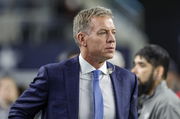
Getty
UNCASVILLE, CT – SEPTEMBER 13: Napheesa Collier #24 of the Minnesota Lynx speaks to the media after the game against the Connecticut Sun during round one game one of the 2023 WNBA Playoffs on September 13, 2023 at the Mohegan Sun Arena in Uncasville, Connecticut. NOTE TO USER: User expressly acknowledges and agrees that, by downloading and or using this photograph, User is consenting to the terms and conditions of the Getty Images License Agreement. Mandatory Copyright Notice: Copyright 2023 NBAE (Photo by Chris Marion/NBAE via Getty Images)

Getty
UNCASVILLE, CT – SEPTEMBER 13: Napheesa Collier #24 of the Minnesota Lynx speaks to the media after the game against the Connecticut Sun during round one game one of the 2023 WNBA Playoffs on September 13, 2023 at the Mohegan Sun Arena in Uncasville, Connecticut. NOTE TO USER: User expressly acknowledges and agrees that, by downloading and or using this photograph, User is consenting to the terms and conditions of the Getty Images License Agreement. Mandatory Copyright Notice: Copyright 2023 NBAE (Photo by Chris Marion/NBAE via Getty Images)
The WNBA was established way back in 1996, yet it’s still nowhere near the NBA’s riches. Players have often pointed out how they never quite get the respect, resources, or recognition they truly deserve. The top rookie picks playing a whole 40-game season in the WNBA make around $76,000. And if you’re the MVP? You get $200,000. Now, compare that to the NBA, where the median salary is around $12 million. With the rise in women’s basketball over the last few years, the WNBA players, including Napheesa Collier, are done ‘taking one for the team’.
Watch What’s Trending Now!
When Journalist Jon Wertheim asked Aliyah Boston a pretty simple question: What’s a fair salary? In the most honest way, she asserted, “I mean, someone like me, I love multiple commas just because we deserve it.” And Napheesa Collier, the vice president of the WNBA executive committee, has her eye on something specific.
“We’re not asking for the same salaries as the NBA. What we’re looking for is rev shares. They’re making that because of rev shares. And so that’s what we’re wanting. That’s how we close that gap,” Collier told CBS News. But who decides how revenue is shared between the league and its players? The CBA (Collective Bargaining Agreement) is wholly responsible for it.
ADVERTISEMENT
Looking at the stats, the WNBA is on the up and up as the revenue jumped to $200 million. Well, all the credits go to increased viewership, sponsorships, and media rights deals. People are watching more than ever, and here we are, not even talking about the social media hype around the games. The 2023 WNBA Finals recorded a 36% jump in viewers.

Getty
MINNEAPOLIS, MN – SEPTEMBER 3: Napheesa Collier #24 of the Minnesota Lynx shoots the ball during the game against the Phoenix Mercury on September 3, 2023 at Target Center in Minneapolis, Minnesota. NOTE TO USER: User expressly acknowledges and agrees that, by downloading and or using this Photograph, user is consenting to the terms and conditions of the Getty Images License Agreement. Mandatory Copyright Notice: Copyright 2023 NBAE (Photo by Jordan Johnson/NBAE via Getty Images)
On top of it, the WNBA Commissioner Cathy Engelbert confirmed the league’s growth and said that financial stability is building. Considering it all, the players are pushing for a fair deal. Right now, the league only gives players around 20% of its revenue—compare that to the NBA’s 50-50 split. If the revenue is there, why aren’t players getting their fair share?
ADVERTISEMENT
Why the Disparity?
There are a number of reasons behind this huge gap. We can’t deny that a part of it comes down to history. The NBA has been around since 1946, which means it had a fifty-year head start to build its brand, audience, and financial empire. However, the WNBA hasn’t always gotten the investment needed to grow at the same pace.
ADVERTISEMENT
Another part of it is societal. Because despite living in this era, women’s sports haven’t always been taken seriously. It’s only now, with social media and more outspoken athletes, that we’re starting to see some real momentum. In Napheesa Collier’s words, the players’ ‘arrival walk’ to the locker room has become a memorable moment.
Now, these aren’t just athletes; they’re role models, fashion icons, influencers. And while we’re primarily discussing revenue sharing, let’s not overlook the broader cultural impact. The new generation is breaking barriers and changing perceptions about what women in sports can do. It is huge! Indeed, the next negotiations are going to be important as players are not just asking for a raise—they’re asking for a ‘fair share of the pie!’
Top Stories
Forced to Leave FOX, Cowboys Legend Troy Aikman Says ESPN Is Like ‘U.S. Government’ & Clearly Distinguishes the Two Networks

Who Is Paige Shiver? All About Michigan Football Staffer & Daughter of Veteran Bears Scout Jeff Shiver

Charley Hull Opens Up on Traumatic Divorce from Ex-Husband for the First Time Ever

Cowboys Legend Troy Aikman Teases NFL Comeback After Airing FOX’s Dirty Laundry

Todd Bowles Points Fingers at Baker Mayfield & Co. in a Strong Statement That Could Get Him Punished After Bucs Loss

LIV Golf to Cut Ties With Veteran Pro After His PGA Tour Return Intentions Became Public

ADVERTISEMENT
ADVERTISEMENT
ADVERTISEMENT

